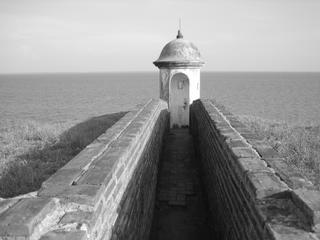I arrived in Macapá around 2 PM. The state tourist kiosk in the airport was useless, having neither a map of the city or state, bus schedules, nor information on attractions. After giving me some glossy brochures with pretty pictures, the person suggested that I visited the main office downtown. I figured that at least I could get a map, but I figured wrong. In addition to some erroneous information, I was again offered the same glossy brochures with pretty pictures. At least I got free coffee and was able to confirm that unless I wanted to take the late bus from Macapá and arrive in Laranjal do Jari around 1 AM, I would have to wait until the 8 AM bus on Saturday. Not being a fan of traveling in a bus along unpaved roads through the rainforest at night, I waited until Saturday.
 On Friday I explored the pleasant and sleepy capital city. After finding a hotel, I visited the big and impressive 18th century Fortaleza de São José which was built to solidify Portuguese control over the upper Amazon and fend off challenges from the French. While Amapá is Brazilian, the French still partly succeeding in taking over, as restaurant menus are bilingual in Portuguese and French and there is a large French cultural center. There were also quite a few French tourists in the capital, and I sat in front of a family speaking French on the 6 hour bus ride to Laranjal do Jari on Saturday.
On Friday I explored the pleasant and sleepy capital city. After finding a hotel, I visited the big and impressive 18th century Fortaleza de São José which was built to solidify Portuguese control over the upper Amazon and fend off challenges from the French. While Amapá is Brazilian, the French still partly succeeding in taking over, as restaurant menus are bilingual in Portuguese and French and there is a large French cultural center. There were also quite a few French tourists in the capital, and I sat in front of a family speaking French on the 6 hour bus ride to Laranjal do Jari on Saturday.The next post will be about Laranjal do Jari, so I’ll recount the remaining attractions of Macapá I visited on Monday. The capital sits on the equator, and city planners are trying to cash in on geography with a cheesy “Marco Zero” monument and stadium.

Marco Zero football (soccer) stadium
with the equator running through the center of the field
Last week Macapá hosted the first annual “Meio do Mundo” (middle of the earth) tourism conference which apparently no one outside of Macapá knew about. For readers wishing to perpetuate the urban legend about the Coriolis effect and the direction of a flushing toilet, I offer the inconclusive piece of evidence that the water in the bowl of the toilet I used at the Marco Zero visitor center neither spins clockwise nor counterclockwise but instead flushes in all directions.
On the outskirts of Macapá is the quilombo of Curiaú. A quilombo is a community descended from runaway slaves that supposedly maintains African traditions. The slave-descendent aspect of Curiaú was a bit of a disappointment as all I saw were wooden houses and a bunch of black people going about their business, but the settlement is near the Curiaú river which has a relaxing place to watch wildlife at sunset.

Curiaú river
No comments:
Post a Comment